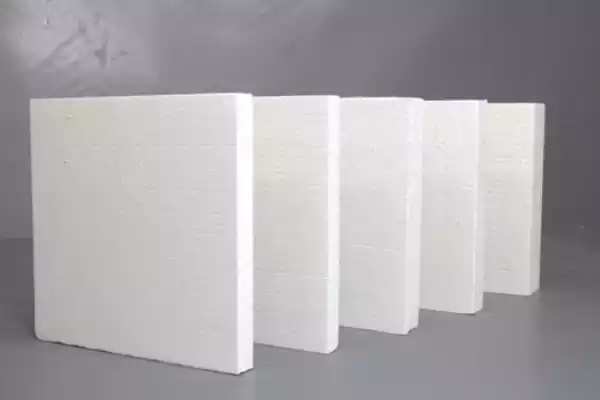Aplicarea plăcii din fibră ceramică de silicat de aluminiu
An aluminum silicate ceramic fiber board is a fiberboard used for heat insulation and can maintain good mechanical strength even under heating.
What is ceramic fiber?
Fibră ceramică cunoscut și sub denumirea de silicat de aluminiu, is a fibrous lightweight refractory material with light, rezistență la temperatură ridicată, conductivitate termică scăzută, and miniature thermal melting.
The production principle of ceramic fiberboard
Fiber is used as the raw material of ceramic fiberboard, and a certain proportion of binder and filler-level additives are added, and it is fully dispersed into a slurry in the slurry mixing tank through a beater. Pump into the forming pool and stir with compressed air. Put the mold into the forming tank, and use the principle of vacuum to make the fiber slurry adsorb on the mold.
Accurately control the adsorption time, vacuum dehydrates the wet fiber material, remove the mold, put it on the tray, and send it to the drying oven for 10-24 ore. The dried fiberboard is passed through a grinder and edge trimmer to precisely control the size. So the size of the ceramic fiberboard can be customized.
Properties of ceramic fiberboard

In addition to the excellent performance of the corresponding loose ceramic fiber cotton, the ceramic fiberboard has a hard texture, excellent toughness, and strength, and excellent wind erosion resistance. It does not expand when heated, is light in weight, convenabil în construcții, and can be cut and bent at will. It is an ideal energy-saving material for kilns, conducte, and other insulation equipment.
Advantages of aluminum silicate ceramic fiber board
- High compressive strength and long service life.
- Capacitate termică scăzută, conductivitate termică scăzută.
- Non-brittle material, duritate bună.
- Accurate size and good flatness.
- Easy to cut and install, convenient for construction.
- Excellent wind erosion resistance.
- Continuous production, uniform fiber distribution, and stable performance.
- Non-brittle material with low heat capacity and low thermal conductivity.
- Good elasticity, wind erosion resistance, and long service life.
- High thermal stability, strong thermal shock resistance, and good anti-stripping performance.
Ceramic fiber application industry

It is used as a furnace lining, thermal insulation, expansion joints, heat separation, and fire protection of each temperature zone of steel, metalurgie, petroleum, chimic, ceramic machinery, metale neferoase, sticlă, and other industrial kilns.
What are the common ceramic insulation materials?

Common ceramic insulation materials include pături din fibră ceramică, ceramic fiber rope, hârtie din fibră ceramică, și ceramic fiber cloth. Different ceramic insulation products are used according to the usage.
Precautions for using ceramic fiber products
Safe operation
When installing, using, and maintaining ceramic insulation products, be sure to follow the relevant safety operating procedures and usage guidelines.
Temperature limits
Make sure that the selected ceramic insulation product can accommodate the required operating temperature range. Exceeding its temperature range may result in material failure or reduced performance.
Installation quality
Correct installation is the key to ensuring the performance of ceramic insulation products. Install according to the installation guidelines provided by the refractory manufacturer and ensure proper fastening, etanșare, and support. Avoid creating voids or gaps to ensure continuity and insulation of the insulation.
Maintenance inspections
Regularly inspect the condition of ceramic insulation products, including damage, corrosion or aging. If a problem is found, repair or replacement measures should be taken in time to ensure its normal heat insulation performance.
Environmental adaptability
Ceramic insulation fiber products should choose materials and types that meet the requirements of the actual working environment. Considering chemical corrosion, mechanical vibration, gas erosion, și alți factori, choose products with high durability and adaptability.
Thermal expansion
The thermal expansion coefficients of the ceramic insulation product and the underlying structure should match. Proper thermal expansion control can reduce thermal stress and the risk of cracking.
Fire resistance
The fire resistance of ceramic fiber products is critical for high-temperature industrial environments. Make sure that the selected product complies with relevant fire resistance standards and has sufficient fire resistance to protect equipment and improve work safety.
 Fabrica de refractare Rongsheng
Fabrica de refractare Rongsheng
WeChat
Scanați codul QR cu wechat